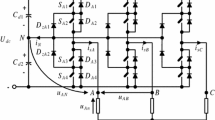Abstract
This paper proposes a control strategy for energy efficiency improvement of three-phase induction motors (TIM). The main control is based on the indirect field-oriented approach. A loss model-based controller is proposed in order to reduce the cooper and iron losses of TIM for different load values. A nonlinear equation based only on quadrature currents is derived and used to obtain suboptimal flux reference in steady-state conditions. Thus, for dynamic implementation (motor transient), a low-pass filter is included and designed based on the rotor time constant. MATLAB simulations are performed to test the proposed strategy for several operation conditions. To verify the approach in real situations, a 4hp motor drive platform was implemented using F28069 DSP. The effectiveness of the proposed model is demonstrated through simulations and experimental results.






















Similar content being viewed by others
References
Barford, N. (1985). Experimental measurements: Precision, error and truth. New York: Wiley.
Castaldi, P., Geri, W., Montanari, M., & Tilli, A. (2005). A new adaptive approach for on-line parameter and state estimation of induction motors. Control Engineering Practice, 13(1), 81–94. doi:10.1016/j.conengprac.2004.02.008. http://www.sciencedirect.com/science/article/pii/S0967066104000449.
de Almeida Souza, D., de Aragao, Filho W., & Sousa, G. C. D. (2007). Adaptive fuzzy controller for efficiency optimization of induction motors. IEEE Transactions on Industrial Electronics, 54(4), 2157–2164. doi:10.1109/TIE.2007.895138.
de Morais Sousa, K., Hafner, A. A., Carati, E. G., Kalinowski, H. J., & da Silva, J. C. C. (2013). Validation of thermal and electrical model for induction motors using fiber bragg gratings. Measurement, 46(6), 1781–1790. doi:10.1016/j.measurement.2013.02.008. http://www.sciencedirect.com/science/article/pii/S0263224113000468.
de Pelegrin, J., Claure Torrico, C., & Carati, E. (2013). A new model based control strategy for energy efficiency improvement of induction motors with variable load. In 2013 Brazilian power electronics conference (COBEP) (pp. 772–779). doi:10.1109/COBEP.2013.6785203.
Diab, A. A. (2014). Real-time implementation of full-order observer for speed sensorless vector control of induction motor drive. Journal of Control, Automation and Electrical Systems, 25(6), 639–648. doi:10.1007/s40313-014-0149-z.
Farasat, M., & Karaman, E. (2011). Efficiency-optimized hybrid field oriented and direct torque control of induction motor drive. In 2011 International conference on electrical machines and systems (ICEMS) (pp. 1–4). doi:10.1109/ICEMS.2011.6073410.
Ganji, A., Guillaume, P., Pintelon, R., & Lataire, P. (1998). Induction motor dynamic and static inductance identification using a broadband excitation technique. IEEE Transactions on Energy Conversion, 13(1), 15–20. doi:10.1109/60.658198.
Levi, E. (1995). Impact of iron loss on behavior of vector controlled induction machines. IEEE Transactions on Industry Applications, 31(6), 1287–1296. doi:10.1109/28.475699.
Moreno, J. F., Hidalgo, F., & Martinez, M. (2001). Realization of tests to determine the parameters of the thermal model of an induction machine. IEE Proceedings Electric Power Applications, 148(5), 393–397. doi:10.1049/ip-epa:20010580.
Ouadi, H., Giri, F., Elfadili, A., & Dugard, L. (2010). Induction machine speed control with flux optimization. Control Engineering Practice, 18(1), 55–66. doi:10.1016/j.conengprac.2009.08.006. http://www.sciencedirect.com/science/article/pii/S0967066109001567.
Palácios, R., da Silva, I., Goedtel, A., Godoy, W., & Oleskovicz, M. (2014). A robust neural method to estimate torque in three-phase induction motor. Journal of Control, Automation and Electrical Systems, 25(4), 493–502. doi:10.1007/s40313-014-0118-6.
Qu, Z., Ranta, M., Hinkkanen, M., & Luomi, J. (2012). Loss-minimizing flux level control of induction motor drives. IEEE Transactions on Industry Applications, 48(3), 952–961. doi:10.1109/TIA.2012.2190818.
Raj, C. T., Srivastava, S. P., & Agarwal, P. (2009). Energy efficient control of three-phase induction motor—a review. International Journal of Computer and Electrical Engineering, 1(1), 61–70. doi:10.7763/IJCEE. http://www.ijcee.org/papers/010.
Scarmin, A., Gnoatto, C., Aguiar, E., Camara, H., & Carati, E. (2010). Hybrid adaptive efficiency control technique for energy optimization in induction motor drives. In: 2010 9th IEEE/IAS international conference on industry applications (INDUSCON) (pp. 1–6). doi:10.1109/INDUSCON.2010.5739975.
Shin, E. C., Park, T. S., Oh, W. H., & Yoo, J. Y. (2003). A design method of pi controller for an induction motor with parameter variation. In The 29th annual conference of the IEEE industrial electronics society, 2003 (IECON ’03) (vol. 1, pp. 408–413). doi:10.1109/IECON.2003.1280015.
Souza, D. A., ao Filho, W. A., & Sousa, G. C. D. (2007). Adaptive fuzzy controller for efficiency optimization of induction motors. IEEE Transactions on Industrial Electronics, 54(4), 2157–2164.
Stumper, J. F., Dotlinger, A., & Kennel, R. (2013). Loss minimization of induction machines in dynamic operation. IEEE Transactions on Energy Conversion, 28(3), 726–735. doi:10.1109/TEC.2013.2262048.
Takahashi, I., & Noguchi, T. (1986). A new quick-response and high-efficiency control strategy of an induction motor. IEEE Transactions on IA Industry Applications, 22(5), 820–827. doi:10.1109/TIA.1986.4504799.
Thangaraj, R., Chelliah, T. R., Pant, M., Abraham, A., & Grosan, C. (2011). Optimal gain tuning of PI speed controller in induction motor drives using particle swarm optimization. Logic Journal of the IGPL, 19(2), 343–356.
Uddin, M., & Nam, S. W. (2008). New online loss-minimization-based control of an induction motor drive. IEEE Transactions on Power Electronics, 23(2), 926–933. doi:10.1109/TPEL.2007.915029.
Verrelli, C., Savoia, A., Mengoni, M., Marino, R., Tomei, P., & Zarri, L. (2014). On-line identification of winding resistances and load torque in induction machines. IEEE Transactions on Control Systems Technology, 22(4), 1629–1637. doi:10.1109/TCST.2013.2285604.
Waheedabeevi, M., Sukeshkumar, A., & Nair, N. (2012). New online loss-minimization-based control of scalar and vector-controlled induction motor drives. In 2012 IEEE international conference on power electronics, drives and energy systems (PEDES) (pp. 1–7). doi:10.1109/PEDES.2012.6484347.
WEG. (2015). Product and service: Electric motors. http://www.weg.net/us/Products-Services/Electric-Motors.
Acknowledgments
The authors thank the Federal University of Technology—Paraná, Catarinense Federal Institute of Science and Technology—Luzerna, FUNTEF, CNPq, CAPES, Fundação Araucária, SETI and FINEP for financial support.
Author information
Authors and Affiliations
Corresponding author
Rights and permissions
About this article
Cite this article
de Pelegrin, J., Torrico, C.R.C. & Carati, E.G. A Model-Based Suboptimal Control to Improve Induction Motor Efficiency. J Control Autom Electr Syst 27, 69–81 (2016). https://doi.org/10.1007/s40313-015-0216-0
Received:
Revised:
Accepted:
Published:
Issue Date:
DOI: https://doi.org/10.1007/s40313-015-0216-0




